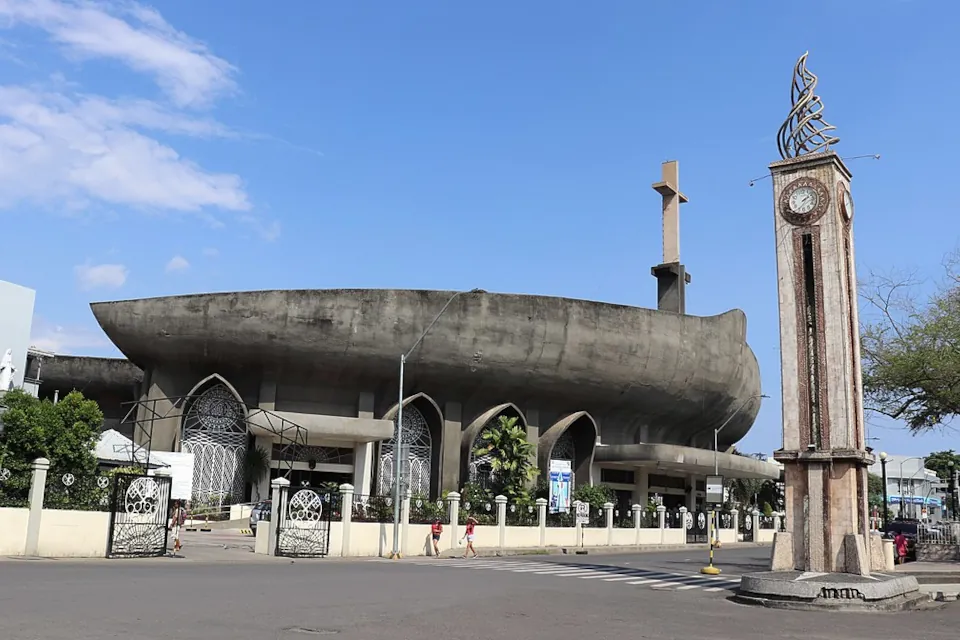 San Pedro Cathedral. (Photo by Teemu Väisänen/Wikimedia)
San Pedro Cathedral. (Photo by Teemu Väisänen/Wikimedia)
Archdiocese of Davao
In the 1930s, Davao’s population increased because of the abaca boom. We became the world’s number one supplier of Abaca through Japanese efforts. Davao was called Little Tokyo because we had the world’s biggest Japanese colony. After World War II ended in 1945, Bishop Thibault had the very heavy duty of rebuilding the church in Davao City (244,000 hectares) and Davao province (now Davao 1. Del Norte, 2. Oriental, 3. Sur, 4. Occidental, 5. De Oro). In 1949, the 2 biggest provinces in the area were 1. Cotabato, and 2. Davao.
In 1949, Bishop Thibault knew that in the coming years, less P.M.E. fathers will be sent to Davao. He began a program to have local priests. The first seminarians were high school students. They went to Ateneo de Davao High and studied at Cebu’s San Carlos Seminary and Manila’s UST. Eighty-two years old Monsignor Ed Rodriguez is the only one left of the first 7 Davao Diocesan priests. The other 6 either left the clergy or are dead.
The bishop knew the Davao church will be happy if it keeps sending seminarians to Cebu and Manila. He decided to open a college seminary but he had no land. The bishop asked my mother who was the Register of Deeds for advice. One of my mother’s friends was Doña Carmen Soriano who owned 250 hectares of land in Catalunan Grande/Pequeño. The successive meetings between the bishop, my mother and Doña Carmen created results. Doña Carmen donated the choicest areas where we now have the St. Francis Xavier Minor College Seminary (6 hectares) and the Regional Major Seminary (3 hectares). Alberto Soriano, one of Doña Carmen’s sons, built the road today called the Holy road because it passes through the 2 seminaries, one church/convents of different congregations of sisters, brothers and priests.
Many of the first settlers helped and donated cash, land, for the increasing number of churches, schools, convents like the Bangoy, Palma Gil, Rasay, Dela Cruz, Monteverde, Joven, Garcia, Tiongko, Suazo, Rodriguez, Reta, Pichon, Hizon, Castillo, Juna Villa-Abrille Tan. Bishop Thibault’s program was continued by his successors, Archbishops Antonio II, Mabutas, Fernando Capalla and Romulo Valles. The heavy load was lightened when in 1967 Davao was divided into 3 provinces, Oriental, Norte and Sur, The Vatican followed up by creating the diocese of Digos, Tagum, and Mati.
Today in Mindanao the Archdiocese of Davao has the 1. Biggest number of faithful almost one Mindanao, 2. Most number of parishes, 44, 3. Most number of GKKs, 1,500 plus, 4. Schools (2 universities, ADDU, Immaculate Conception University, Holy Cross of Davao plus 4 other colleges, 3 minor seminaries, Xacose, Redemptorist, Sacred Heart.) We also have the first college/minor seminary (Xacose) with the biggest number of seminarians, the first major (ReMaSe) seminary with the biggest number of future priests and has produced the biggest number of bishops and archbishops (Bishops Valles, Tonel, Apigo, Afable, etc.) and priests.
Bishop Thibault as a P.M.E used his congregations connection in Canada, France and America to create an advance study program for the priests. Successor Archbishop Mabutas, Capalla and Valles followed his lead. Monsignor Rodulfa studied in St. John University, New York, and Bishops Valles, Tonel in Liturgical University. The Davao Oppus Dei sent to Universidad de Navarra in Pamplona, Basco Region, Spain more than 12 priests including fathers, Allan Rodriguez, Junar Dela Victoria, Paul Cuison etc.. The archdiocese has the biggest number of priests in Mindanao with advance graduate degrees who may be potentially qualified to be bishops and Archbishops. The first Davao parish was created about 100 years ago. Daygon ta ang Ginoo. Salamat Ginoo sa imong kaayo!


No Comments